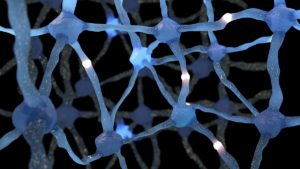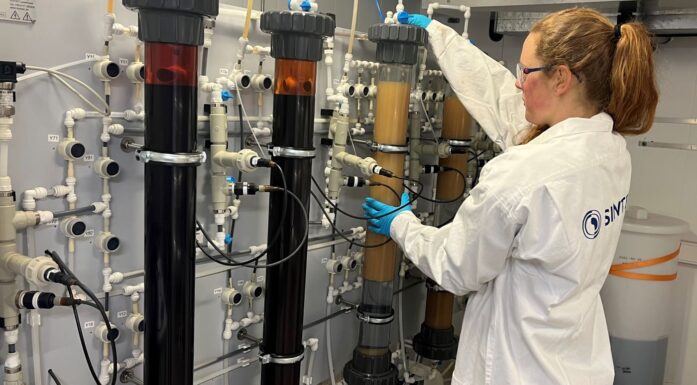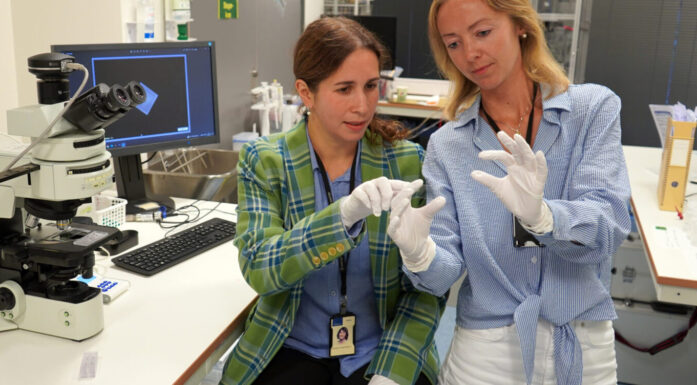BLOG: Can we build artificial brain networks using nanoscale magnets?
Researchers apply advanced mathematical models and powerful computers to understand what happens when nanoscale magnets are made to mimic the synchronized activity of brain neurons.
BRAIN NETWORKS: Examples of synchronized activity can be found many places in nature – for example fireflies starting to flash in unison, or humans breaking into rhythmic applause after a concert.
Examples can also be found in the brain, where synchronous electrical activity has been found between neurons in distinct brain regions. Research has shown that this activity might play an important role in performing cognitive tasks and in forming memory.
What do these phenomena have to do with nanoscale magnets?
As it turns out, these various phenomena share a common denominator in that they are connected via “the mathematics of synchronization”.
Even though they are vastly different, these phenomena can actually be described remarkably well using the same mathematical equations, all connected by the common concept of synchronization.
One of the more well-known mathematical models used to study synchronization is the Kuramoto model. The Kuramoto model has been used to describe the essential features of oscillations in a vast set of biological and physical phenomena, where an oscillator in this sense is any system that shows periodic behaviour. A swinging pendulum, for example, returns to the same point in space at regular intervals, where these intervals correspond to the oscillator’s frequency.
The focus of our latest research has been on understanding the behaviour of nanoscale magnetic oscillators. These oscillators measure only a few hundred nanometres.
In comparison, a human hair has a thickness of approximately 100,000 nanometres (one nanometre is 0.000000001 meter, so they are pretty small!).
Artificial neural networks
Scientists have envisioned them being useful for a variety of magnetic nanodevices, such as microwave sources, and for signal processing in telecommunication technologies. Another very interesting proposal is the use of such oscillators as building blocks for the implementation of artificial neural networks, inspired by how the brain functions.
Building artificial neural networks is an emerging field of research in bio-inspired computing. Here, researchers look to nature for inspiration in the development of bio-inspired chips based on natural computing architectures. The brain, and biological systems in general, are able to perform high-performance calculations much more efficiently than computers, and they do it quickly and with minimal energy consumption.
Interestingly, recent advances in nanotechnology and materials science are finally making it possible to envision designing and building networks based on multifunctional nanodevices that approach the complexity of biological systems.
Interaction
We are now getting closer to our initial question, “Can we build artificial brain networks using nanoscale magnets?” Crucial to achieving this is to understand what happens when you put a lot of these magnetic oscillators together and allow them to interact with each other. This is what we have been focused on.
In order for the magnetic oscillators to “agree” on a common frequency, they need to be able to interact with each other. This means that by packing several of them close together, their interactions could result in a collective behaviour of all the oscillators, i.e. they all become synchronized.

Recent advances in nanotechnology and materials science are finally making it possible to envision designing and building networks based on multifunctional nanodevices that approach the complexity of biological systems. Illustration: Thinkstock
This is where things get interesting: understanding the behaviour of a single oscillator is not that hard (although it can be complicated enough!), but the real challenge lies in understanding the collective behaviour when you pack a lot of oscillators together.
A mathamatical model
This leads us to one of the main questions we wanted to address in our research: What happens when you closely pack a lot of these oscillators together, allowing them to interact? Will they synchronize to a collective rhythm, or might some other interesting effects occur?
We studied this by using mathematical equations we could solve on our computers. Inspired by the successful use of the Kuramoto model in describing a vast set of different phenomena related to synchronization, we wanted to see if a similar “simple” mathematical model could be found for a large number of interacting magnetic oscillators. The short answer here is yes, we think so.
In our recent article, we showed how this mathematical model could be used to describe the collective behaviour in large networks of these magnetic oscillators. Then we presented an analogy between systems of interacting oscillators, e.g. in neuroscience, and these magnetic oscillators, as they both can be described by similar mathematical equations.
Possible to build

So, returning again to our initial question: building an artificial brain, in the sense of a human brain, might be difficult. However, being able to build artificial neural networks that perform computations inspired by how the brain performs cognitive tasks is a more likely outcome. Illustration: Thinkstock
So, returning again to our initial question: building an artificial brain, in the sense of a human brain, might be difficult. However, being able to build artificial neural networks that perform computations inspired by how the brain performs cognitive tasks is a more likely outcome.
Part of the puzzle in achieving this goal is to identify suitable elemental building blocks. In this context, nanoscale magnetic oscillators show promise for implementing neural networks based on neuron-emulating nanodevices.
We find it very interesting that the mathematical equations used to study synchronous neural activity in the brain can also be used to study the synchronization of these magnetic oscillators. However, with many issues yet to overcome and problems to solve, only continued hard work over the coming years will show whether such devices will become a reality in the futre. In the meantime, we are excited to contribute our small piece of the puzzle to this field of research.
Read the article i Scientific reports.
This blog is also published at NTNU TechZone.
Front page photo: Vegard Flovik. Photo: Per Henning/NTNU






